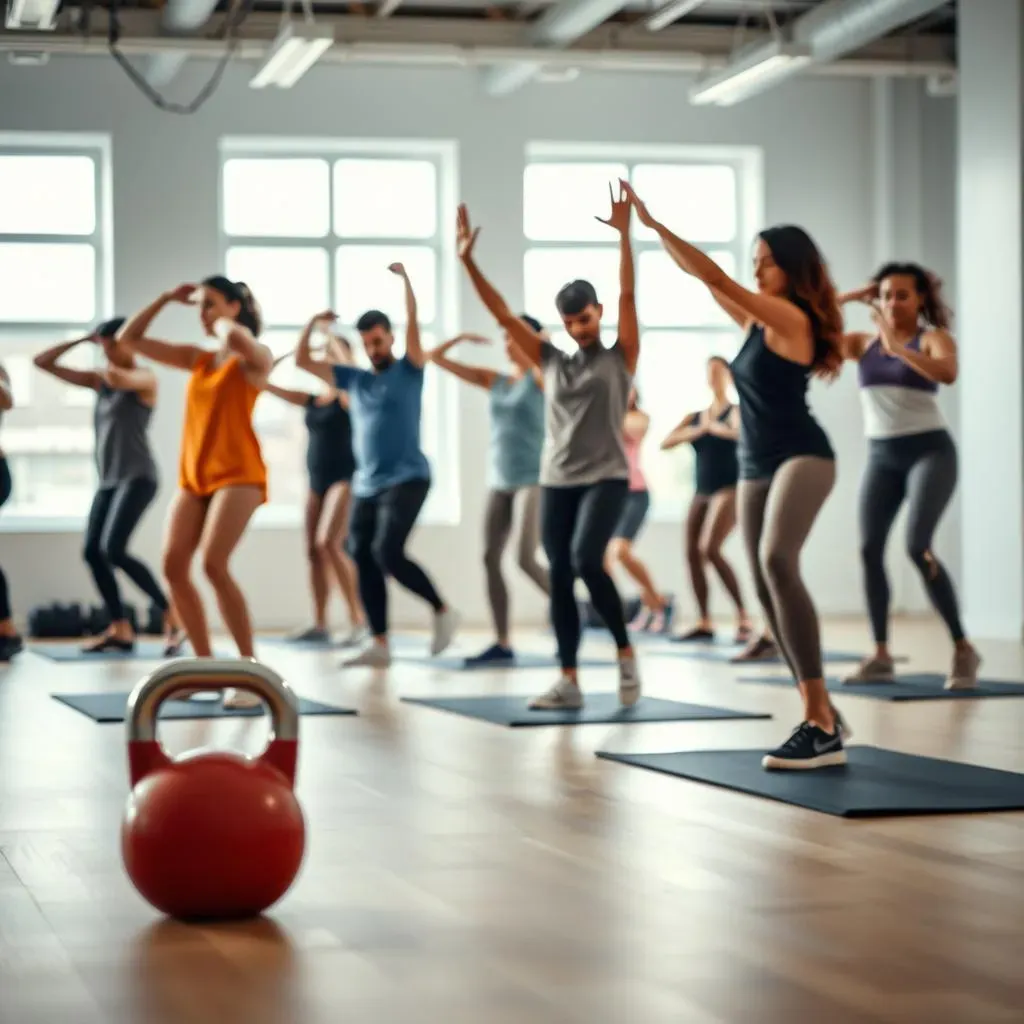Table of Contents
Ready to torch calories and build serious strength? Let's face it, finding time for fitness can be a real struggle. But what if I told you that just one hour with a kettlebell could transform your body? This isn't some hyped-up fitness fad; a well-structured 1 hour kettlebell workout is a powerhouse for total body conditioning. Forget endless cardio – we're talking about functional movements that translate to real-world strength. In this guide, we'll break down how to maximize your time and effort. I'll show you how to warm up properly, design a routine that hits every muscle group, and select the best kettlebell exercises for a full-body blast. Whether you're a seasoned kettlebell enthusiast or a complete beginner, I've got you covered. Get ready to swing, squat, and snatch your way to a fitter, stronger you. Let's get started!
WarmUp and CoolDown Essentials for Your Kettlebell Workout

WarmUp and CoolDown Essentials for Your Kettlebell Workout
Why Warm-Up and Cool-Down Matter
Skipping your warm-up is like trying to drive your car full speed on a freezing morning. Something's gonna break, and it probably won't be pretty. A good warm-up primes your muscles, gets your blood flowing, and boosts your range of motion. It's not just about preventing injuries; it's about maximizing your performance during the actual workout.
And the cool-down? That's your body's chance to recover and rebuild. It helps flush out lactic acid, reduces muscle soreness, and gradually brings your heart rate back to normal. Think of it as hitting the brakes gently instead of slamming into a wall.
Dynamic Warm-up Examples:
- Arm circles
- Leg swings
- Torso twists
- Walking lunges
- High knees
Crafting the Perfect Warm-Up
A solid warm-up should last about 5-10 minutes and include dynamic stretches. Forget holding static stretches before your workout; those are better saved for the cool-down. Dynamic stretches involve movement, which helps to actively prepare your muscles for the workout ahead. Think arm circles, leg swings, and torso twists.
Specifically for kettlebells, incorporate movements that mimic the exercises you'll be doing. For example, if your workout includes kettlebell swings, do some bodyweight swings or light kettlebell swings to get your hips and core engaged. If you are planning on presses, do some arm circles.
Effective Cool-Down Techniques
Your cool-down should also be around 5-10 minutes. Focus on static stretches, holding each stretch for 20-30 seconds. Target the muscles you worked during your kettlebell session, such as your hamstrings, quads, glutes, and shoulders. Deep breathing is also key to help lower your heart rate and promote relaxation.
Don't just flop on the couch the second you're done. Light cardio, like walking, can also aid in recovery. It helps to keep the blood flowing and prevent muscle stiffness. I like to take a leisurely stroll around the block after a tough workout; it's a great way to clear my head, too.
Designing Your 1 Hour Kettlebell Workout Routine

Designing Your 1 Hour Kettlebell Workout Routine
Structuring Your Workout
So, you've got an hour and a kettlebell – now what? Don't just jump in and start swinging wildly; a little planning goes a long way. I like to break down my 1 hour kettlebell workout into segments: warm-up (5-10 minutes), strength exercises (35-40 minutes), and cool-down (5-10 minutes). The strength portion is where the magic happens, and we'll focus on compound movements that work multiple muscle groups at once. This maximizes your calorie burn and builds overall strength efficiently.
Think about dividing your strength session into circuits. A circuit involves performing a series of exercises back-to-back with minimal rest. After completing all exercises in the circuit, you take a longer rest before repeating the circuit again. This keeps your heart rate up and your muscles working hard. For a 1-hour workout, aim for 3-4 circuits with 3-5 exercises each.
Choosing the Right Exercises and Reps
Not all kettlebell exercises are created equal. Focus on compound movements that give you the most bang for your buck. Swings, squats, presses, rows, and lunges should be your bread and butter. These exercises work multiple muscle groups simultaneously, leading to greater strength gains and calorie expenditure. Isolation exercises, like bicep curls, can be added but should not be the focus.
As for reps and sets, aim for 3-4 sets of 8-12 reps for each exercise. Adjust the weight of the kettlebell so that you can complete the reps with good form. It's better to start with a lighter weight and gradually increase it as you get stronger. Remember, form is king! Sacrificing form for heavier weight is a surefire way to get injured. I had to learn that the hard way after ego lifting led to a tweaked shoulder.
Workout Component | Time | Focus |
|---|---|---|
Warm-up | 5-10 minutes | Dynamic stretching, light cardio |
Strength Exercises | 35-40 minutes | Compound movements, circuits |
Cool-down | 5-10 minutes | Static stretching, deep breathing |
Kettlebell Exercises to Include in Your 1Hour Workout

Kettlebell Exercises to Include in Your 1Hour Workout
Must-Do Kettlebell Exercises
Alright, let's get down to the nitty-gritty: the exercises themselves. If you only have an hour, you need to focus on movements that give you the most bang for your buck. That means compound exercises that work multiple muscle groups simultaneously. The king of all kettlebell exercises is, without a doubt, the kettlebell swing. It works your glutes, hamstrings, core, and shoulders. Plus, it's a fantastic cardio exercise. Other essential exercises include squats (goblet squats, front squats), lunges (reverse lunges, lateral lunges), presses (overhead press, push press), and rows (kettlebell rows, renegade rows). These movements will form the foundation of your 1-hour kettlebell workout.
Don't forget about variations! Once you've mastered the basic movements, you can start to incorporate variations to keep things interesting and challenge your body in new ways. For example, try single-leg deadlifts instead of regular deadlifts, or try alternating arm rows instead of standard kettlebell rows. These variations will help to improve your balance, coordination, and overall strength.
Sample Kettlebell Workout Circuit
Here's a sample circuit you can use as a starting point for your 1-hour kettlebell workout. Remember to adjust the weight and reps based on your fitness level. Perform each exercise for the prescribed number of reps, then move on to the next exercise with minimal rest. After completing all exercises in the circuit, rest for 1-2 minutes before repeating the circuit. Aim for 3-4 rounds.
This is just a template, feel free to customize it to fit your needs and preferences. If you hate lunges, swap them out for something else! The most important thing is to find a workout that you enjoy and that you'll stick with. And, of course, always listen to your body. If something doesn't feel right, stop and adjust your form or choose a different exercise. Nobody wants to get hurt!
Exercise | Reps | Sets |
|---|---|---|
Kettlebell Swings | 15 | 3-4 |
Goblet Squats | 10 | 3-4 |
Overhead Press (each arm) | 8 | 3-4 |
Kettlebell Rows (each arm) | 10 | 3-4 |
Walking Lunges (each leg) | 10 | 3-4 |
Wrapping Up Your 1-Hour Kettlebell Transformation
So, you've got the tools, the knowledge, and the motivation to conquer your own 1 hour kettlebell workout. Remember, consistency is key. Don't get discouraged if you don't see results overnight. Stick with it, listen to your body, and progressively challenge yourself. Kettlebells offer a fantastic way to build strength, improve cardiovascular fitness, and boost your overall well-being. Now go out there and make that hour count!